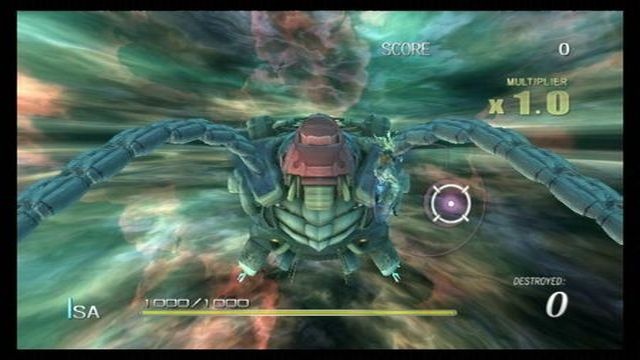UK REVIEW-- For those who enjoyed the N64's Sin and Punishment, either on import or later via Virtual Console download, this glorious Wii follow-up, also an on-rails shooter, is a no-brainer. Sin and Punishment: Successor of the Skies (known as Sin and Punishment: Star Successor in North America) improves on its predecessor in every respect. For everyone else, this game's nonstop creativity will be a treat, too.
Successor of the Skies is set years after the first game and follows two kids called Isa and Kachi as they do battle with military types, mechs, and outlandish animals. It all takes place in, around, and far above a future Japan. Isa is the son of the original game's main characters. Kachi appears to be, but isn't, a young girl. The plot, such as it is, may seem like nonsense, and there's not much more to it than laid out here. But that's no complaint. This is a game about spectacle and action, not story, and it manages both very well.
You play from a third-person perspective, pointing and shooting with the Wii Remote and using the nunchuk to dodge around the screen while you're scrolled through the game's seven stages. The Classic Controller and GameCube Controller are also supported, but the motion-control shooting works so well these are hardly called for. Kachi and Isa each have a melee attack for hitting enemies who get up close and a charged shot for doing massive, explosive damage. Unlike in the original game, you can fly--using a jetpack if you've picked Isa or a hoverboard if you're playing as Kachi. This gives Kachi or Isa full roam of the screen where you traverse with the analog stick and perform a quick dodge manoeuvre via the Z button.
The game's abundance of ideas and variety of action is admirable. Sometimes the camera will swing to one side, turning it into a side-scrolling or vertically scrolling shooter. At another point, the game briefly becomes a side-on brawler, giving a twist to the finale of one boss fight. The quality and variety of visual design is likewise dazzling, to the point where the sometimes less-than-pretty textures are eclipsed. The on-rails experience takes in sky fortresses, space stations, lava submarines, haunted forests, and underwater tunnels. These are variously populated with soldiers, elaborate robots, chimera-like beasts, bioluminescent fish, and screen-filling bosses. You encounter bosses and minibosses frequently and, like the environments and ordinary enemies, they are hugely, gratifyingly inventive. A voodoo-styled boss with a bird skull on her head fires exploding lotuses and time-bending ravens at you. Another boss transforms into a colossal manta ray and then into a school of flipping, laser-equipped dolphins. Each boss is uniquely memorable and, happily, tough enough to make each encounter feel epic.

As is traditional, the boss battles are multistage affairs in which you chip away at a vast health bar that passes through all the colours of the rainbow on its way down to zero. In the absence of checkpoints during these battles (elsewhere, checkpoints are generously doled out), the game is at its most brutally challenging but it never quite strays into frustrating difficulty. That said, the ability to switch between difficulty modes on the fly would still be welcome. As it is, the only way to switch among easy, normal, and hard is to start again or to have already unlocked that stage at that difficulty on a previous play-through. An experienced player on a high-score (that is, no-death) run might manage one of these in just three or four hours, but the average player should expect up to six hours for a single play-through. Though it's not an especially long game (it doesn't need to be), its replay value is high, with online leaderboards for players to compete on and personal records to beat.
Scoring is based on a multiplier system that rewards stringing together kills without getting hit, so dodging is crucial. There's often a single, small safe patch on the screen, with the rest filled with lasers, fire, floating mines, boulders, missiles, and other glowing, exploding, or destructive items. This leaves you navigating a hazard-filled screen with one hand and shooting with the other. Doing both at once, with one eye on a distant enemy's movement and another on the shifting pattern of deadly things in the foreground, is key, and there's a great deal of satisfaction to be had in mastering it.
The two-player mode is a letdown. Rather than putting a second character on the (admittedly crowded) screen, the mode adds a second targeting reticle. The second player becomes not much more than an assistant; he or she may be good for a little extra damage, picking up some extra points, and clearing the screen of hazards but has no special attacks. With nothing to do but paint targets with the Wii Remote, the second player's experience is diluted beyond recognition. The weak co-op offering aside, Sin and Punishment: Successor of the Skies impresses with its gratifying action and wealth of ideas. Wii owners owe it to themselves to experience a high-energy on-rails shooter with this diverse and fresh-feeling game.